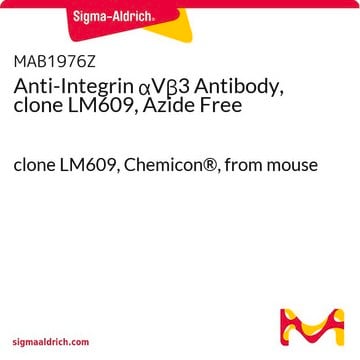おすすめの製品
由来生物
mouse
品質水準
抗体製品の状態
purified immunoglobulin
抗体製品タイプ
primary antibodies
クローン
B3A, monoclonal
化学種の反応性
human
メーカー/製品名
Chemicon®
テクニック
flow cytometry: suitable
western blot: suitable
NCBIアクセッション番号
UniProtアクセッション番号
輸送温度
wet ice
ターゲットの翻訳後修飾
unmodified
遺伝子情報
human ... ITGB3(3690)
関連するカテゴリー
特異性
ヒトインテグリンβ3に特異的(他の動物種で試験されていません)
免疫原
胎盤から分離したヒトインテグリンαVβ3ヘテロ二量体
アプリケーション
フローサイトメトリー
インテグリンβ3を介したECMタンパク質への接着機能を阻害できます。
ウェスタンブロッティング(還元条件)最適なワーキング希釈倍率は、ご自身で決定してください。
インテグリンβ3を介したECMタンパク質への接着機能を阻害できます。
ウェスタンブロッティング(還元条件)最適なワーキング希釈倍率は、ご自身で決定してください。
抗インテグリンβ3抗体クローンB3A、アジ化物不含は、インテグリンβ3量の検出において、FC、FUNC、WBでの使用が文献発表され、検証されています。
研究カテゴリー
細胞構造
細胞構造
研究サブカテゴリー
インテグリン
インテグリン
ターゲットの説明
110 kDa
物理的形状
フォーマット:精製
プロテインA精製マウス免疫グロブリン抗体、20 mM リン酸ナトリウムバッファー(pH 7.6)+250 mM NaCl溶液、保存剤不含
精製プロテインA
保管および安定性
2–8°Cで出荷日から1年間保存できます。凍結融解を繰り返さないために、分注してください。製品を最大限回収するために、融解後のキャップを外す前に元のバイアルを遠心分離します。
アナリシスノート
コントロール
ポジティブコントロール:U251またはD54ヒト細胞株ウェスタンブロッティングでは膜の調製を推奨します。
ヒト内皮細胞(インテグリンαVβ3の発現は、ホルボールエステル刺激によって上方制御する必要があるかもしれません)。 皮膚(基底膜)
ポジティブコントロール:U251またはD54ヒト細胞株ウェスタンブロッティングでは膜の調製を推奨します。
ヒト内皮細胞(インテグリンαVβ3の発現は、ホルボールエステル刺激によって上方制御する必要があるかもしれません)。 皮膚(基底膜)
その他情報
濃度:ロットに固有の濃度につきましては試験成績書をご参照ください。
法的情報
CHEMICON is a registered trademark of Merck KGaA, Darmstadt, Germany
免責事項
メルクのカタログまたは製品に添付されたメルクのその他の文書に記載されていない場合、メルクの製品は研究用途のみを目的としているため、他のいかなる目的にも使用することはできません。このような目的としては、未承認の商業用途、in vitroの診断用途、ex vivoあるいはin vivoの治療用途、またはヒトあるいは動物へのあらゆる種類の消費あるいは適用などがありますが、これらに限定されません。
Not finding the right product?
Try our 製品選択ツール.
保管分類コード
12 - Non Combustible Liquids
WGK
WGK 2
引火点(°F)
Not applicable
引火点(℃)
Not applicable
適用法令
試験研究用途を考慮した関連法令を主に挙げております。化学物質以外については、一部の情報のみ提供しています。 製品を安全かつ合法的に使用することは、使用者の義務です。最新情報により修正される場合があります。WEBの反映には時間を要することがあるため、適宜SDSをご参照ください。
Jan Code
MAB2023Z:
試験成績書(COA)
製品のロット番号・バッチ番号を入力して、試験成績書(COA) を検索できます。ロット番号・バッチ番号は、製品ラベルに「Lot」または「Batch」に続いて記載されています。
María Anguiano et al.
PloS one, 15(1), e0220019-e0220019 (2020-01-17)
The migration of cancer cells is highly regulated by the biomechanical properties of their local microenvironment. Using 3D scaffolds of simple composition, several aspects of cancer cell mechanosensing (signal transduction, EMC remodeling, traction forces) have been separately analyzed in the
María Anguiano et al.
PloS one, 12(2), e0171417-e0171417 (2017-02-07)
Microfluidic devices are becoming mainstream tools to recapitulate in vitro the behavior of cells and tissues. In this study, we use microfluidic devices filled with hydrogels of mixed collagen-Matrigel composition to study the migration of lung cancer cells under different
Marta Irigoyen et al.
Molecular cancer, 9, 130-130 (2010-06-01)
Lung cancer is one of the most prevalent neoplasias in developed countries. Advances in patient survival have been limited and the identification of prognostic molecules is needed. Resistance to treatment is strongly related to tumor cell adhesion to the extracellular
Clementina Auriemma et al.
Cellular & molecular biology letters, 15(3), 496-506 (2010-06-08)
Listeria monocytogenes enters non-phagocytic cells by binding its surface proteins inlA (internalin) and inlB to the host's E-cadherin and Met, respectively. The two internalins play either separate or cooperative roles in the colonization of infected tissues. Here, we studied bacterial
H Jacques Garrigues et al.
Virology, 464-465, 118-133 (2014-07-27)
Cellular receptors for KSHV attachment and entry were characterized using tyramide signal amplification (TSA)-enhanced confocal microscopy. Integrins αVβ3, αVβ5 and α3β1 were detected on essentially all the actin-based cell surface microdomains that initially bind KSHV, while the presence of CD98
ライフサイエンス、有機合成、材料科学、クロマトグラフィー、分析など、あらゆる分野の研究に経験のあるメンバーがおります。.
製品に関するお問い合わせはこちら(テクニカルサービス)








